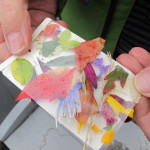 This lesson is all about using language in the garden. It can be done at any time of year, but autumn/fall is ideal. This project could be simply about observing the plants colour and shape, but it can also lead onto some wonderful creative writing and poetry.
This lesson is all about using language in the garden. It can be done at any time of year, but autumn/fall is ideal. This project could be simply about observing the plants colour and shape, but it can also lead onto some wonderful creative writing and poetry.
Age range: Suitable for all primary and secondary school pupils.
The wonderful Eden Project outdoor learning team, taught this lesson to me. Check out their website for many great lesson plans.
 http://www.edenproject.com/learn-with-us
http://www.edenproject.com/learn-with-us
Preparation
- Cut out rectangular shapes of card (which can then be used as book marks) or you could use a leaf shape or a circle.
- In lines, stick double-sided tape over the whole of one side of the piece of card.
The lesson
- Discuss observation. Talk to the children about how they need to move about slowly, crouching down and really examining their environment.
- Peel off the double-sided tape so as not to litter the garden with the discarded strips. Make sure they do not touch the sticky side of the tape.
- Ask the pupils to look around the garden to find any fallen leaves, flowers sticks, feathers etc. to stick on their colour palette. Do not pick anything that is growing.
You can tailor what is collected to the age you are teaching. Make it more challenging by stipulating different shapes or textures. You could also ask them to define their own category and explain why they grouped their items together.
- When everyone has finished, ask each pupil to describe his or her palettes.
- Note down a list of adjectives they have used with chalk on the floor.
- You can read out a suitable poem to help think about their describing words.
- The children could pick four or five of the listed adjectives to write a short poem.
- Children can then write their poems on the floor with chalks for all to see and discuss.






 Resources
Resources






Keep in touch